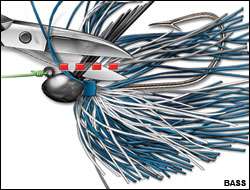
When boys are born, some fathers will place a small baseball mitt in their crib. Legend has it that Chad Brauer's basinet contained an assortment of Strike King jigs.
With a last name like Brauer, how could the Missouri pro not be destined to become a jig expert like his father, Denny, who has ridden the rubber-skirted, bottom-bumping baits to more than $2 million in BASS earnings?
Like his father, Chad is an unabashed jig man. It's doubtful that even his father carries more jigs to tournaments. And few can match his intricately organized tackleboxes containing his favorite lures.
"It may seem like a little bit of overkill, but I actually carry three jig boxes in my boat all of the time," said the BASS champion.
"The lure I toy with the most is probably jigs. I'll have different sections of jigs in those boxes that are prepared for different types of situations. I've got jigs for every situation."
When he's done arranging his arsenal, Brauer's boxes include specially modified versions best suited for different situations in each of his four favorite colors: Texas craw (black/chartreuse/green/pumpkin); black/blue; chameleon craw/brown; and green pumpkin.
"I've got my jig boxes almost dialed in now to where I have three or four different colors that I cover everywhere, but I've done different things to those colors," he explained. "I'll have slots in that tacklebox for black/blue jigs. In one slot, I'll have black/blue jigs where I've trimmed down the skirt almost to the shank of the hook. Then I'll have another slot for black/blue jigs that I've barely trimmed at all, to make them bulkier for when I want it to fall a little bit slower.
"Then I'll have a couple of different slots with black/blue jigs that have been trimmed a little differently. I'll trim them to where it's maybe 1/4 inch behind the back of the hook. And I'll have one that's trimmed kind of diagonally, into kind of a diamond shape, which gives it a little more of a baitfish appearance."
Brauer, who trims most weedguards parallel with the shank of the jig hook so as not to hamper hook penetration, also modifies his jigs specially for aquatic vegetation and rock.
When fishing rock, he believes the weedguard is "almost useless," because most snags occur when the jig falls between the rocks. So he leaves just six or seven strands in place in case he encounters a stray stick or other object.
"For fishing jigs in grass, I tend to thin out the weedguard a little bit," Brauer added. "Not quite as much as I would for rock, but I will thin it down because a lot of times when you're fishing stuff like milfoil, the grass doesn't tend to catch on the hook. It catches on the head of the jig. So, the weed guard isn't helping you out as much. And when you pitch in the grass, you'll have that cushion in your line where it's bent 90 degrees into the mat. With that cushion, a little less weedguard helps you hook those fish a little bit better."




